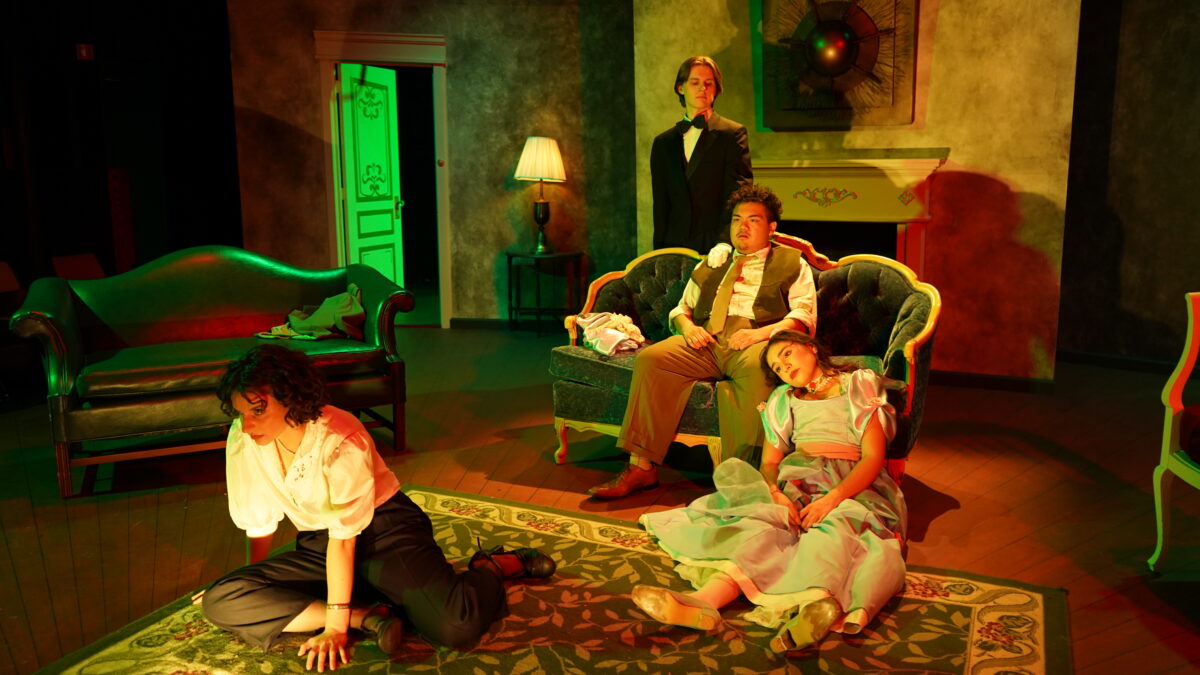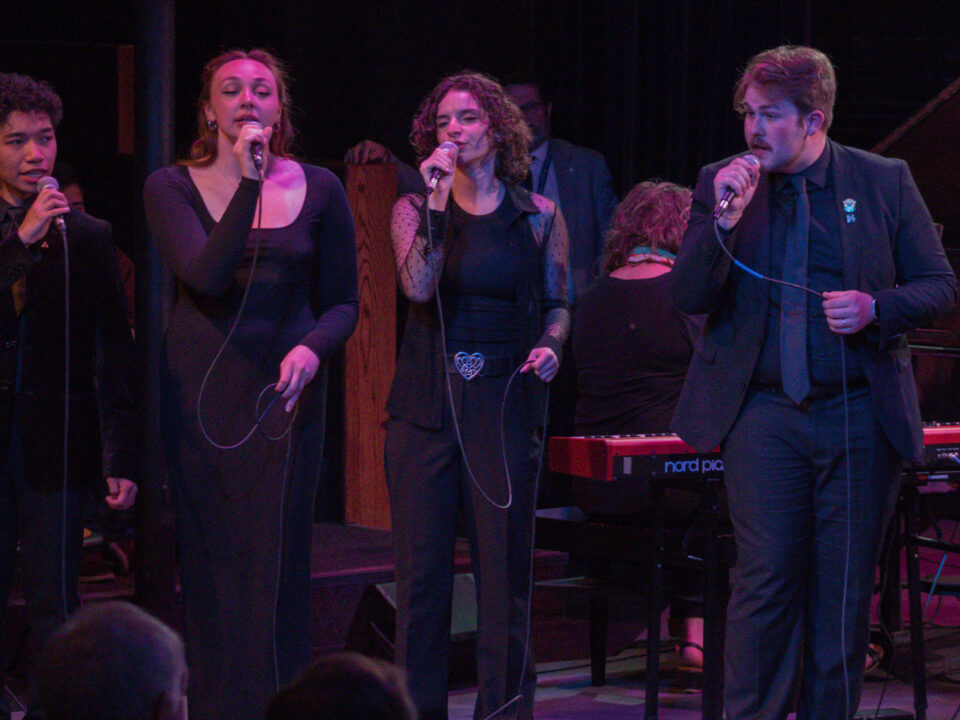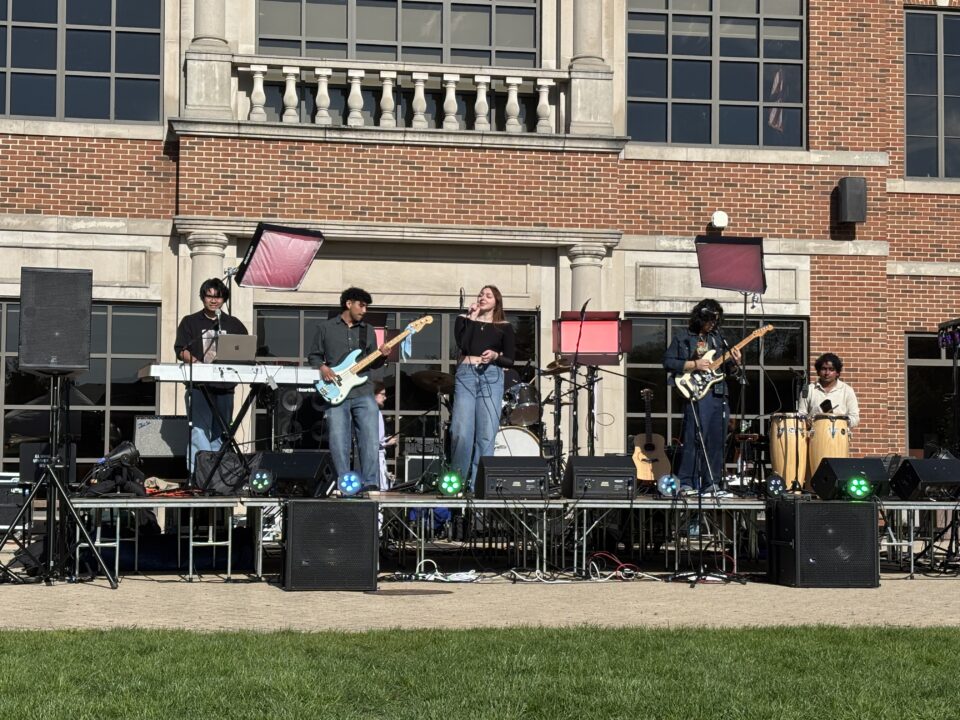“Hell is other people”: A “No Exit” Review

Jazz filled the newly dimmed theatre as the crowd sat in anticipation. The door opened and two men dressed in formal wear emerged, one guiding the other through his new circumstances. We learn the confused man is Mr. Garcin, played by Aron Gomez, a late journalist who has now arrived in hell. Garcin worriedly asked the unnamed Valet, played by Maddux Masopust, about the rules of the room whilst dabbing a cloth on his perspiring face. The Valet, unamused as he has done this a million times before, answers all Garcin’s questions before departing.
Later, a stylish woman named Inez, played by Regan Bobich, is brought into the same room by the Valet. She is bluntly annoyed with Garcin and brushes off the opportunity to ask the Valet questions, who is taken aback by her lack thereof. Inez and Garcin continued to butt heads, and both actors truly embodied their characters while speaking in an old-Hollywood tone that sounded like honey but had words of venom.
“The language is so unlike many modern plays,” Bobich explained in an interview. “It’s not Shakespeare-esk, but it’s definitely not contemporary English.”
A final person is brought into the room, a rich socialite named Estelle, played by Ella León. Unlike Garcin and Inez, Estelle is in denial of her being in hell. She can’t even bear to say dead, she insists on referring to them as “absentees” instead. Inez was instantly attracted to her, whereas Estelle only desires the eye of a man — any man — this one happened to be Garcin. León’s mannerisms perfectly captured how I thought Estelle would move and behave, very delicately and thought out.
As the play continued, the three continued to butt heads with each actor demonstrating the unique way each character copes. We see glimpses into their past through how the ones who knew them coped. We see Garcin’s grieving wife and former boss, Estelle’s sister, as well as her best friend Olga and former side-lover Peter, and the new occupants entering Inez’s room.
The shadow actors were doused in red lights, having red and black accents representing their separation from the hell we find the three characters in.
Micaiah Brown, Garcin’s wife, demonstrated the complexity of grief in abusive relationships all without uttering a single line. I deeply sympathized with the sadness and anger written all over Brown’s face.
I could feel the chemistry between Olga, played by Treasure Indiamaowei, and Peter, played by Brenden Infante, as they danced with one another, silently whispering sweet nothings.
I find it incredibly interesting the way they react to their former relationships. Estelle seems genuinely convinced she is a good person, but we discover she murdered her baby and pushed a lover to suicide. León truly demonstrated how it is to witness someone who’s so ‘sweet’ show their true colors, the mask slowly began to slip in such a subtle way.
With Inez, we don’t see her loved ones. We see a heterosexual couple moving in and Inez, a lesbian, is disgusted by the idea that he is going to “make love to her on my [Inez’s] bed.” Bobich shows the stages of grief Inez goes through as she realizes she has “no more alibis” to keep her window open to earth.
Learning Inez was a postal worker shocked me, as Bobich carried Inez’s character with such grace and charm. The outfit choice was dripping in sophistication, potentially representing a level of denial Inez has about her life’s circumstances.
Garcin is the last to have his window to the world closed, and he briefly mentioned how his wife died months after it happened. Gomez’s portrayal of Garcin’s anger reminded me of many angry arrogant men I’ve known, I could find myself giggling hard at Inez’s jabs. I was surprised he was the last to be spoken of, I figured Estelle out of everyone would have been last, but I suppose it highlights fleeting friendships in the world of socialites.
Garcin describes their predicament perfectly, that “hell is other people.” They all anticipated the traditional torture in the beginning but slowly began to realize it was the eternal company of each other.
Overall, Gomez, Bobich, and León captured the descent into madness as each character began to accept their fate in quite a thought-provoking manner. I’ve been thinking about their performances ever since I saw the show.
When speaking with Bobich, she revealed Inez isn’t the kind of character she typically plays. This surprised me, as she was able to embody a very blunt and cold person very well (when she was truly a sweetheart afterward.)
Masopust’s performance left me deeply unsettled, but that’s exactly how the character is supposed to make you feel. The Valet is a very ominous presence, and I was a bit nervous to compliment him after the show. Masopust ended up being very approachable, I didn’t recognize him out of costume at all.
Lizzie Eschenbrenner, the costume designer, did a fabulous job of capturing each character’s essence. I couldn’t imagine better outfits to put them in. Their outfits added a complementary accent to each character’s couch.
The set designer, Elle Ziemianin, and the lighting designer, Delilah Quintanar, came together magically to bring the play to life. Shockingly, this was Ziemianin’s first time designing a set — but the work was so solid I couldn’t tell at all.
The set was absolutely stunning, and the light design was captivating. Color is very crucial to the nonverbal storytelling, with three drastically different couches being the centerpiece of the set. I found myself staring at the strange structure on the wall, trying to figure out exactly what it was.
When speaking with Derek Liavas, the director, he expressed his thoughts on the play in a way I can completely agree with:
“I love the whole philosophical, psychological elements that Sartre put into it as an existentialist philosopher,” Liavas said. “It really tackles what it means to be a human in a world that is not perfect, and I think we can all kind of relate to that right now.”
“To everyone who came to see the show, I’m so glad that you were able to possibly experience something out of the ordinary,” Bobich said. “Also to see our hard work, everyone across the board – director, stage manager, technicians, actors – we all work so hard to put on this piece and I’m so glad we were able to do it in such an interesting and special space.”


